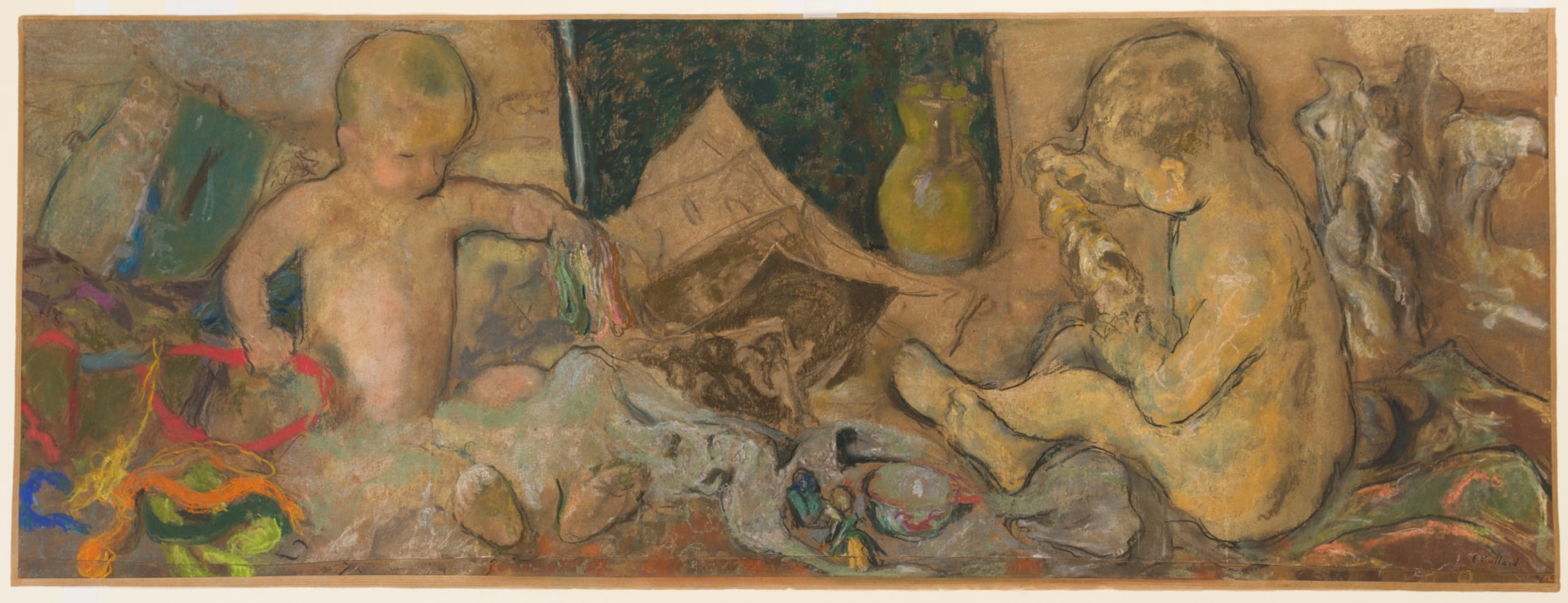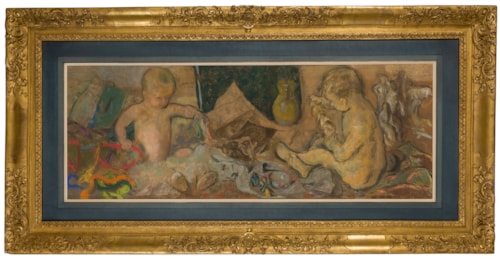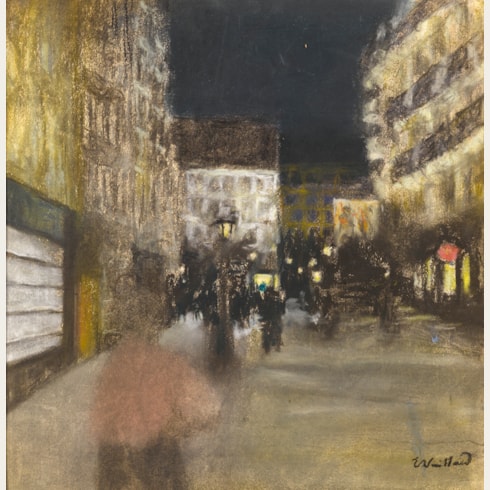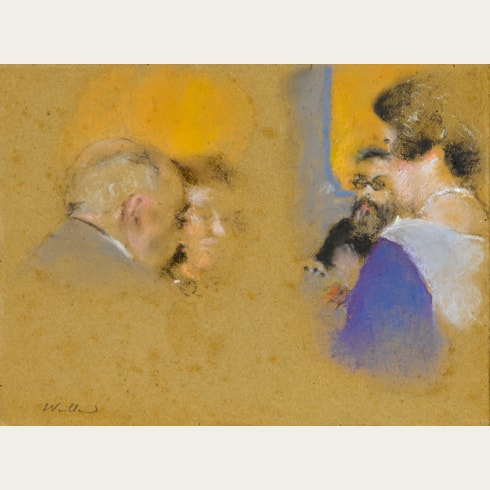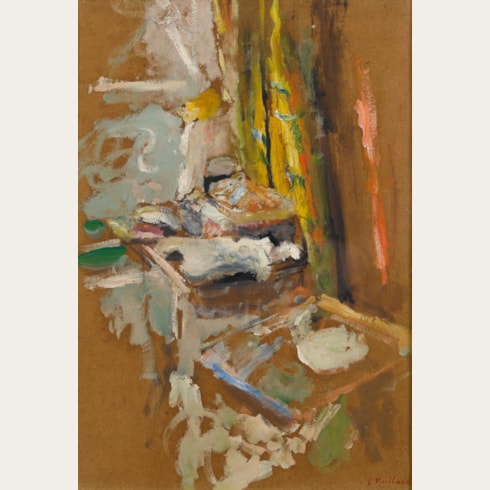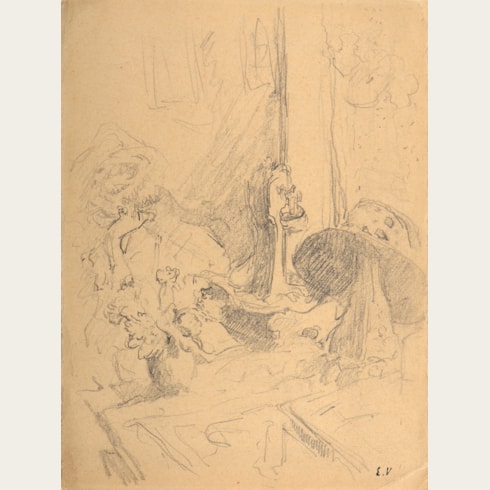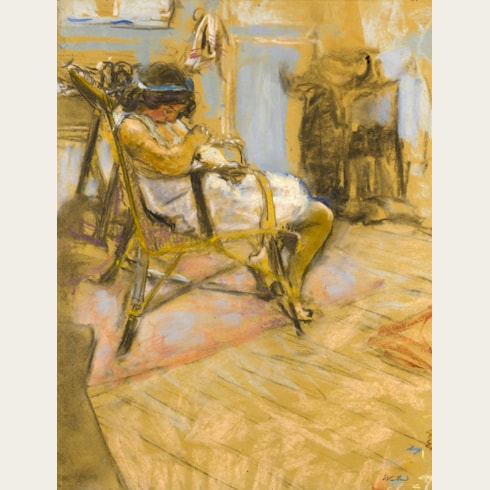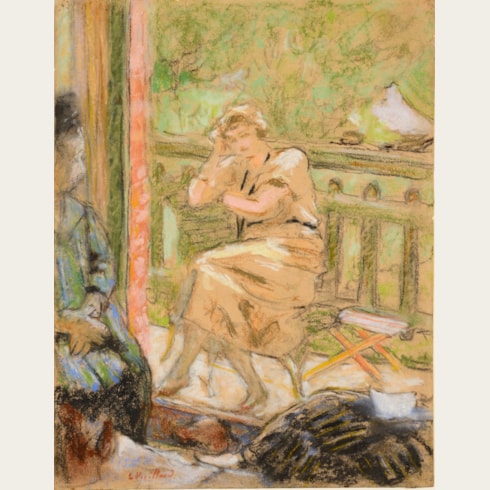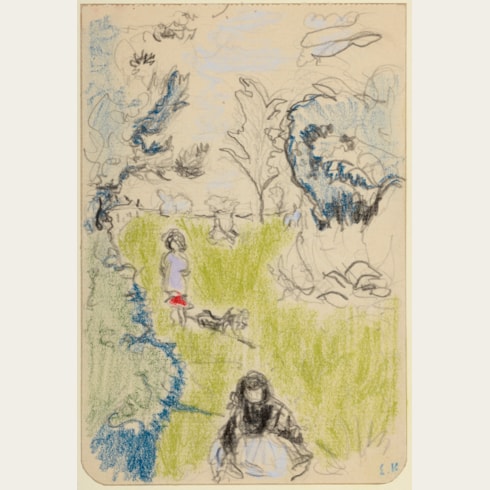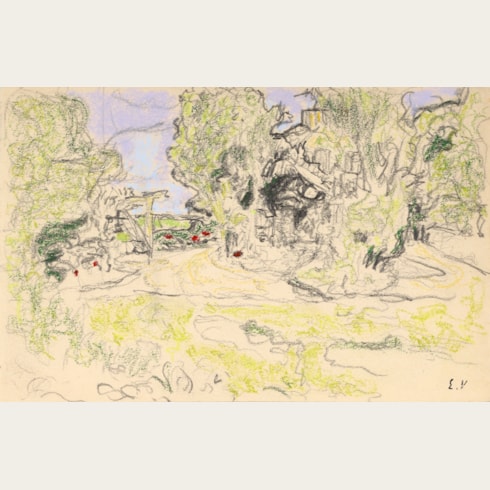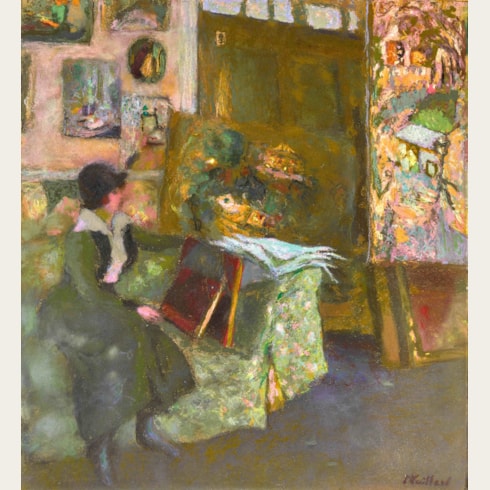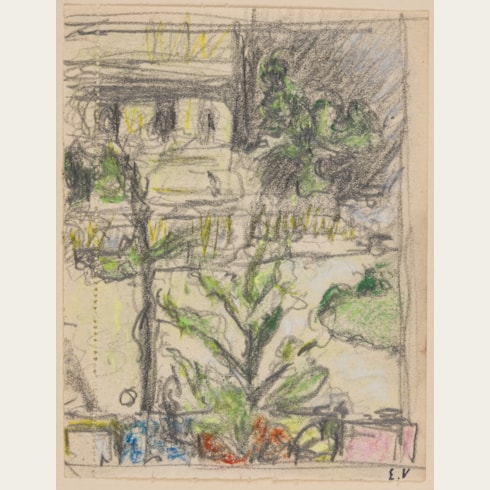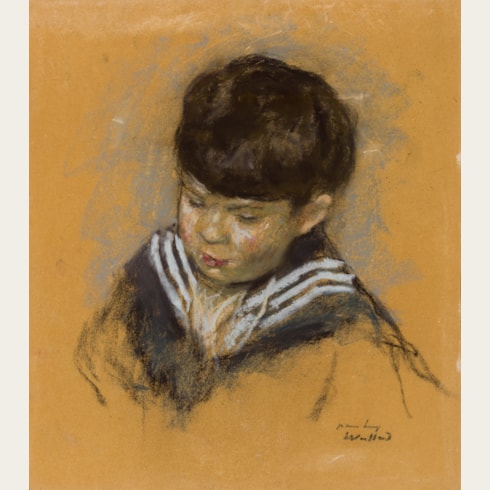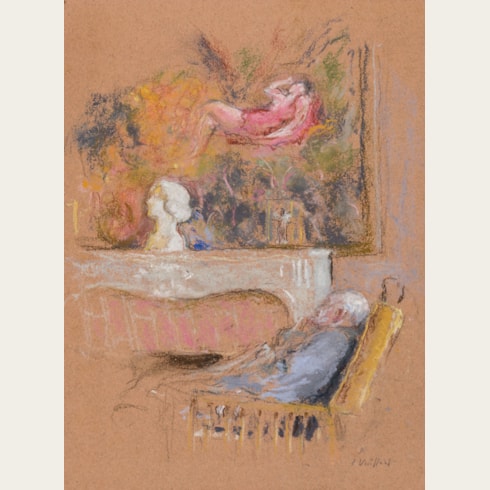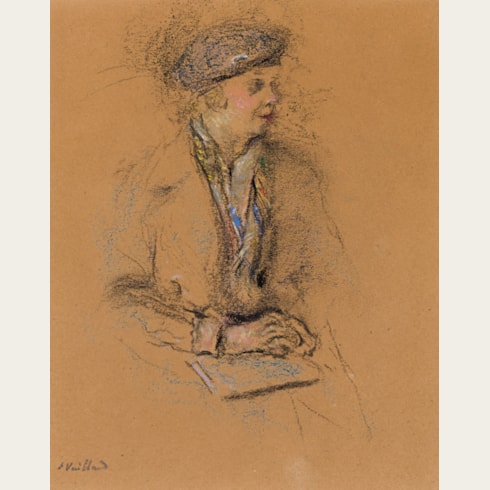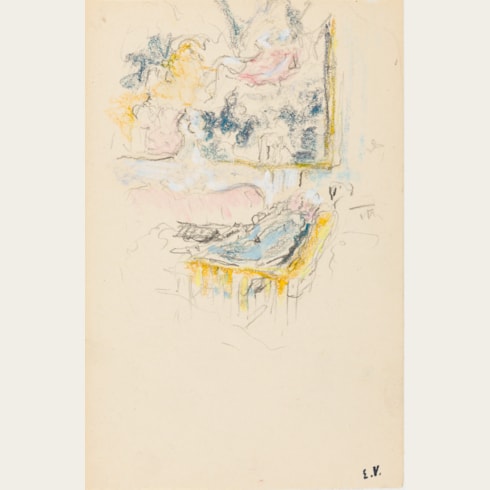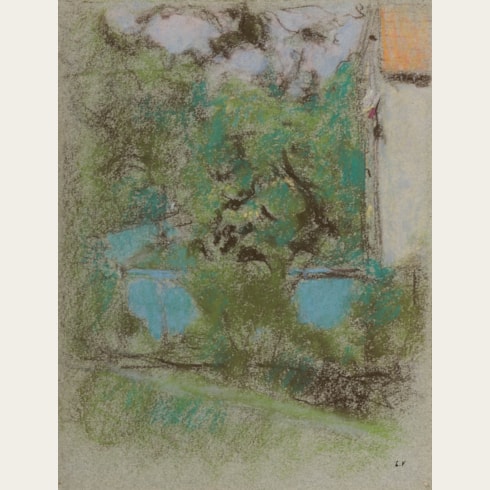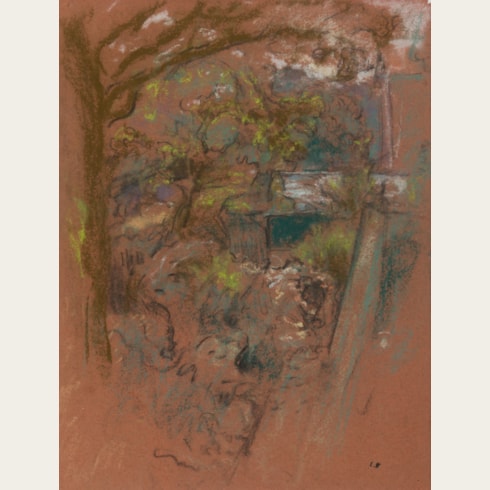Edouard VUILLARD
(Cuiseaux 1868 - La Baule 1940)
Two Young Children at Play
A narrow strip of paper (between 4 and 8 mm. in height) added by the artist along the bottom edge of the composition.
Stamped with the atelier stamp (Lugt 2497a) at the lower right.
403 x 1091 mm. (15 7/8 x 43 in.) [sheet]
This large pastel is a preparatory study for the composition of a pair of oil paintings by Vuillard of c.1915, formerly with Wildenstein in New York and later in a private collection. The two paintings - which may at one time have made up one single work - each depict half of the composition of the present pastel. Together they make up a decorative frieze-like painting, of nearly identical dimensions to the present sheet, showing the complete arrangement of two children at play among the papers and materials of the artist’s studio. As the composition of the painting has been described, ‘A fair-haired and a dark-haired child seated facing one another, playing, the one on the left with brightly coloured threads of tapestry, the other with modelling clay. In the right half the colours are bright and the child is rendered in pink flesh-tones; in the left half, the colours are more subdued and the child’s flesh is rendered in a cold half-tone. To the right of centre is a jug of anemones on the green ground of a portfolio; on the far right, a group of statuettes.’ Vuillard’s painting shows several differences with the present sheet, however. For example, the empty vase in the centre of the composition is filled with flowers in the painting, while the child at the right has more hair than in the pastel than in the painting.
A related painting of the same composition, executed in oil on cardboard, is in the collection of the Musée Cantonal des Beaux-Arts in Lausanne. The painting was commissioned from the artist in 1915 by Émile Lévy, the owner of a printing shop, for his offices at 73 rue Claude Bernard in Paris, but after Lévy’s death the following year was purchased from the artist by the Swiss physician Dr. Henri-Auguste Widmer.
As Antoine Salomon and Guy Cogeval note, ‘The first mention of a commission for a decorative frieze from Émile Lévy appears in the artist’s journal for 5 February 1915: ‘at Émile Lévy’s[,], question [of] decorative art[,] asks me again [for a] small panel.’…The subject was a most unusual one for Vuillard: two babies playing, surrounded by tapestry-works, statuettes and a jug of anemones. The painter was once again influenced by eighteenth-century overdoors depicting putti at play surrounded by plant motifs. Boucher painted several works of this kind, as did Le Moyne…This astonishing, horizontal panel is certainly one of those which posed the greatest difficulties for Vuillard and…fills page after page of his Journal. It was the range of colours that have him the most trouble; he began, therefore, with a grisaille of monochrome greys, returning to it time and time and again and struggling to define an overall harmony for several weeks…The ‘finished’ panel was delivered on 18 September 1915, but Vuillard went on touching it up until the sudden death of his patron on 26 January 1916. Some time after this, Dr. Widmer…offered to acquire the panel for 500 francs. Vuillard accepted his offer but continued touching it up until April 1916, at which time it entered Dr. Widmer’s collection in Switzerland.’ The Lévy-Widmer painting can be seen on the easel in a photograph taken by Vuillard of his studio on the Rue de Calais in Paris in c.1916.
Vuillard produced several preparatory studies for the Lévy commission. A preparatory sketch for the entire composition, executed in pen and ink on papier calque, was on the art market in Germany in 1996, while a large compositional study in distemper appeared at auction in Paris in 1960. Two separate pastel studies for each of the pair of oil paintings are in a private collection, while one for the whole composition is in another private collection. A large pastel sketch for the entire composition was exhibited in Japan in 1979-1980 and is today in a private collection.
At the start of his career, Edouard Vuillard joined a group of young artists - including Maurice Denis, Paul Sérusier, Pierre Bonnard and Kerr-Xavier Roussel - who called themselves the Nabis and were united by a desire to develop a new, more expressive pictorial language, inspired by the work of Paul Gauguin. In the 1890's, Vuillard began receiving a number of private commissions for wall panels intended to decorate the rooms of private houses. This was a genre in which he was to become very successful, and between 1892 and 1901 he painted a number of these large-scale panneaux décoratifs, almost all the result of commissions from a small group of mutual friends and enlightened collectors. Vuillard’s work of this type remained largely unknown to the public at large until several panels were exhibited at the Salon d’Automne in 1905.
In the early years of the new century, enjoying the fruits of a commercial arrangement with the Galerie Bernheim-Jeune, Vuillard began expanding his repertoire of decorative panels and small, intimiste domestic interiors to include portraits and landscapes. Although his work as a peintre-décorateur was largely confined to private homes, he did receive a handful of public commissions, including the decoration of the foyer of the newly built Théâtre des Champs-Elysées in 1912. The later years of his career found Vuillard saw mainly as a portrait painter, often depicting his sitters within an interior setting. He rarely exhibited in public after 1914, and it was not until a large retrospective exhibition of his work was held at the Musée des Arts Décoratifs in Paris in 1938, two years before his death, that interest in Vuillard was renewed.
As a modern scholar has noted, ‘Vuillard was in many ways the supreme graphic artist among the Nabis. He drew throughout his life, indeed daily...’ From around 1900 onwards he used mainly pastel for his drawings, and came to master the subtlety and vibrancy of this challenging medium. In one of the first monographs on the artist, the critic and art historian Claude Roger-Marx wrote that, ‘Vuillard often found expression by means of pastels’, and he made more extensive use of the pastel medium than perhaps any French artist since Degas in the previous generation. Pastel was to become an essential part of Vuillard’s working process until the end of his career, and was used for landscape and figure studies, compositional drawings, still life subjects and as preparatory studies for portraits.
Provenance
Probably by descent to the artist’s sister, Mme. Ker-Xavier Roussel
Hallsborough Gallery, London
Anonymous sale, London, Sotheby’s, 1 December 1965, lot 123 (bt. Tillson for £900)
Galerie Römer, Zurich, in 1983
Private collection
Anonymous sale, Luzern, Galerie Fischer, 21 November 1998, lot 2189 (bt. Colnaghi)
P. & D. Colnaghi, London, in 1999
Gemstone Holdings Ltd., Hong Kong
Private collection.
Literature
Exhibition

